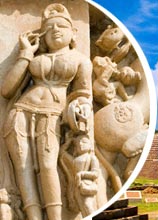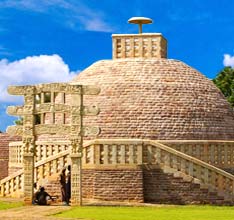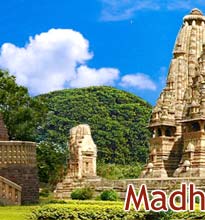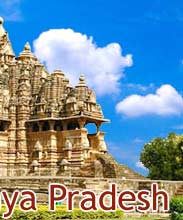 Madhya
Pradesh boasts of a rich historical past and associates its name with
many ruling dynasties of India. Thus, the state exhibits a landscape
bequeathed with various trademark preferences of these rulers. It also
claims distinction for snuggling three prominent World Heritage Sites,
as declared by UNESCO, namely Khajuraho temples, Bhimbetka Caves and
Sanchi Buddhist monuments. Each of them is an architectural
representation that pays tribute to the rulers under whose regime it saw
construction and to the deftness and precision of artisans who shaped
it.
Madhya
Pradesh boasts of a rich historical past and associates its name with
many ruling dynasties of India. Thus, the state exhibits a landscape
bequeathed with various trademark preferences of these rulers. It also
claims distinction for snuggling three prominent World Heritage Sites,
as declared by UNESCO, namely Khajuraho temples, Bhimbetka Caves and
Sanchi Buddhist monuments. Each of them is an architectural
representation that pays tribute to the rulers under whose regime it saw
construction and to the deftness and precision of artisans who shaped
it.While the temples and Sanchi monuments depict beauty achievable in stone, Bhimbetka Caves pictorially represent the magnificence of art. Apart from them, the state also preserves many other monuments, each of them as appealing as the other. There are architectural legerdemains of Mughals, Paramaras, Holkars and Scindias. Adding on to them are some of the most beautiful mosques built during the rule of Begums. Singular in stance, steeped in history and immaculate in exposition; each monument of the state whispers a unique story of its own.
Khajuraho Temples
Khajuraho temples, entwined with spiritualism and eroticism, top the charts of Madhya Pradesh monuments. Located in Khajuraho village, these temples have been declared as a World Heritage Site by UNESCO. The 22 temples of Khajuraho, with their architectural vividness, still testify the unique theories pertaining to life, love and sex by the Chandela Rajputs. Divided into various groups, these temples cover an area of 8 sq miles.
Sanchi Stupas
Enlisted as UNESCO World Heritage Site, the Buddhist monuments of Sanchi, earn special mention due to their meticulous architecture. These ancient specimens of Buddhist art and architecture in Sanchi date back to the early Mauryan Empire (3rd century BC to 12th century AD) and thus, form the footnote for understanding birth, flowering and culmination of Indian Buddhism. Apart from stupas & monasteries, there are also chaityas, gateways and temples in Sanchi.
Rajwada
Rajwada Palace is an exquisite fusion of French, Mughal & Maratha architectural style and is a legacy of the Holkar rulers in Indore. With a 200-year-old history, this seven-storied edifice is an arresting monument in the heart of the city. Its upper floors are made of wood, while the lower three floors are made of stone. The place suffered three fire breakouts, the most devastating one in 1984. The rubble of the rear portion, with landscaped gardens & ponds, forms a major draw.
Lal Bagh Palace
Lal Bagh Palace is notable for its rich history and impressive architecture. Built in 1886 by Tukoji Rao Holkar II, its construction was carried out in three phases finally saw completion in 1921, under Tukoji Rao Holkar III. Its classic architecture, complemented by sprawling lawns, is a remarkable sight. Today, a part of the building converted into a museum preserves rare murals and other antique artifacts belonging to the Holkars.
Jai Vilas Palace
A gleaming white sandstone palace, Jai Vilas Palace of Gwalior was built by Sir Michael Filose. Designed to resemble an Italian palazzo, the palace was built to welcome the 'Prince of Wales'. It edifice magnificently synthesizes Italianate structure, with Tuscan and Corinthian architectural modes. Today, 35 of its many rooms form the Jai Vilas Museum and display the royal memorabilia of the Scindias, along with other regal splendors culled from all across the globe.
Jahaz Mahal
Built in the 15th century, by Sultan Ghiyas-ud-din-Khilji to maintain his large harem, Jahaz Mahal of Mandu simulates a floating ship. It lies on a narrow strip of land between the two lakes, Munj Talao to the west and Kapur Talao to the east. The double-storied pleasure palace presents a hypnotic picture, with balconies hanging over the water and gaping terraces. Witnessing the eerie silhouette of the structure in a moonlit night is an experience of its own.
Baz Bahadur's Palace
Surrounded by green vistas, Baz Bahadur Palace was built in the 16th century. The ostentatious halls and high terraces of the building resonate with the imperial stamp of Baz Bahadur and magnify its rich architecture. Beautifully amalgamated with Rajasthani and Mughal architectural style, the palace rests atop a hillock above Rewa Kund, & is part of the 'Rewa Kund Group of Monuments' in Mandu.
Hoshang Shah's Tomb
A monument believed to provide the inspirational notes towards the construction of the Mahal, Hoshang Shah's Tomb is the first marble edifice built in India. Erected in the 15th century, the tomb is entirely sheathed with white marble and is a tribute to the magnificence of Afghan architecture. Located in Mandu, the monument is adorned with delicate latticework and towering domes. Scrupulous observation will also reveal certain Hindu patterns in its architectural decorations.









